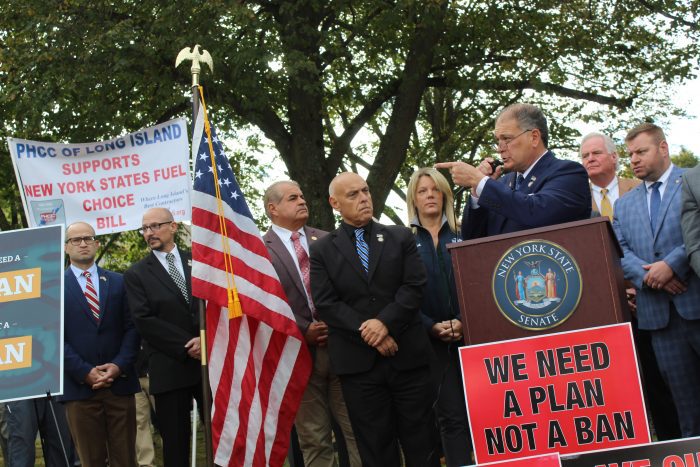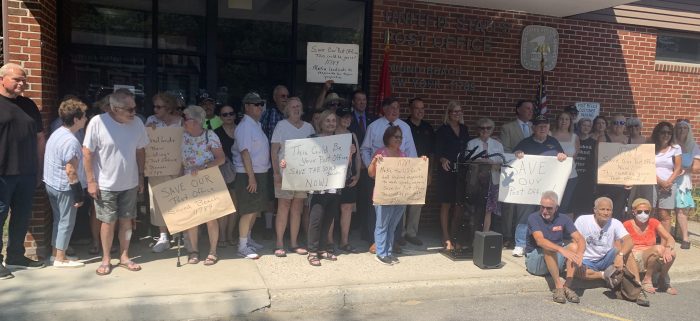New York State’s ban on natural gas is coming under fire.
Dozens of public officials, union workers and policy advocates rallied outside the Perry B. Duryea Jr. State Office Building in Hauppauge Wednesday morning, Oct. 18, protesting the state’s recent ban on natural gas, slated to take effect on Dec. 31, 2025.
During the rally, attendees chanted, “We need a plan, not a ban.”News Flash:
Generated by ChatGPT, edited by our staff
- Protest against New York State’s natural gas ban: Public officials, union workers and policy advocates rally against New York State’s ban on natural gas, expressing concerns about its impact on jobs, energy prices and the economy.
- Legal challenge to the ban: Plaintiffs in the Mulhern Gas Co. v. Rodriguez lawsuit argue that the ban violates federal law, specifically the Energy Policy and Conservation Act.
- Calls for realistic energy approaches: Opponents of the natural gas ban advocate for a balanced and diversified energy portfolio, highlighting the challenges of transitioning to an all-electric system.
This natural gas provision was included in this year’s fiscal year budget, passed by the Democratic-controlled state Legislature and signed by Gov. Kathy Hochul (D) in May.
The law bans gas-powered stoves, furnaces and propane heating, encouraging using climate-friendly appliances such as heat pumps and induction stoves in new residential buildings. It also requires all-electric heating and cooking in new buildings shorter than seven stories by 2026 and for taller buildings by 2029.
New York State Sen. Mario Mattera (R-St. James), ranking member on the Senate Energy and Telecommunications Committee, offered several objections to the natural gas ban, fearing the measure would trigger layoffs and hiring freezes, spike energy prices and exacerbate the region’s unaffordability crisis and overtaxed electrical grid.
“We know that this is going to hurt not just our homeowners but our economy,” Mattera said. “We are here today to say stop with this unrealistic ban and come together to create a realistic plan.”
Those gathered Wednesday strongly supported the plaintiffs in Mulhern Gas Co. v. Rodriguez, who seek to invalidate the ban on the legal grounds that the federal Energy Policy and Conservation Act preempts the state law.
“New York State’s law violates the United States Constitution,” said Town of Babylon Supervisor Rich Schaffer (D), who is also affiliated with the Plumbing Contractors Association of Long Island, one of the plaintiffs in the lawsuit. “This law that was passed and signed is unconstitutional. So that means it’s an opportunity to go back to the drawing board.”
New York State Assemblyman Mike Fitzpatrick (R-Smithtown) endorsed a more diversified energy portfolio for Long Island to meet the demands of today’s modern economy. While he expressed support for promoting alternative energy sources, he suggested these alternatives are still not yet economically viable to stand alone.
“Consumers are not ready for what the radical environmentalists have planned for us,” the assemblyman said. “People want to turn on the electricity or turn on that gas and cook a nice meal for their families. They can’t do it all-electric.”
State Sen. Jack Martins (R-Old Westbury) said Long Island’s electrical grid cannot handle an electric-only transition. He noted the potential dangers of an electric-only energy economy, pointing to frequent outages due to downed trees and storms. “If we don’t have an alternate means of powering our homes, people are going to get hurt,” he warned.
Union leaders from across industries spoke out in opposition to the natural gas ban. Richard Brooks, business manager for Plumbers Local 200, referred to natural gas as “an essential transitional fuel that will help our nation as we move to greener energy sources.”
“New York’s natural gas ban will unnecessarily hurt New York workers by removing our members’ jobs at a time when we are already leading the nation in the expansion of alternative energy for New York residents,” he added.
To view a recording of the entire rally, visit www.facebook.com/senatormariomattera.
















